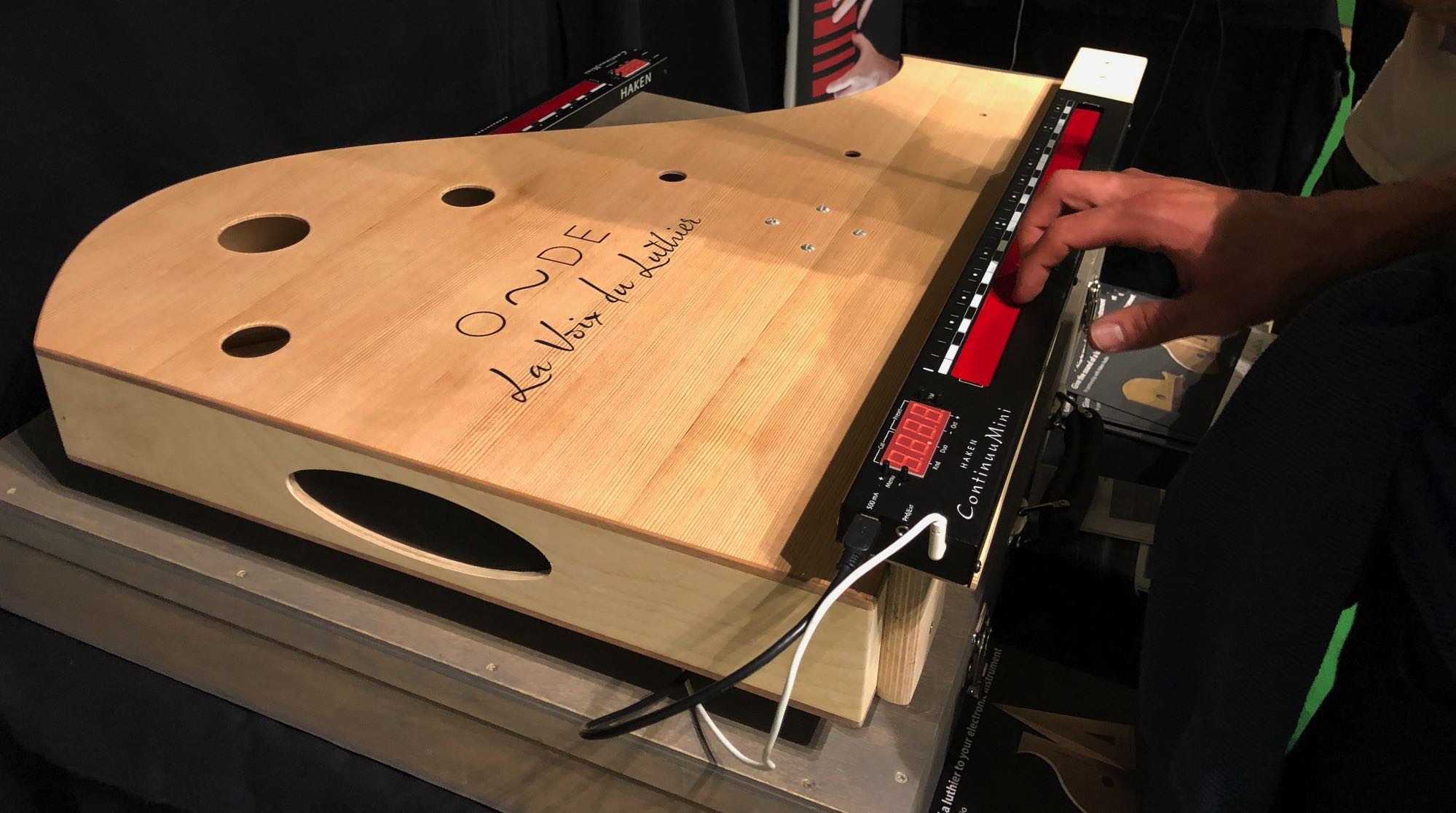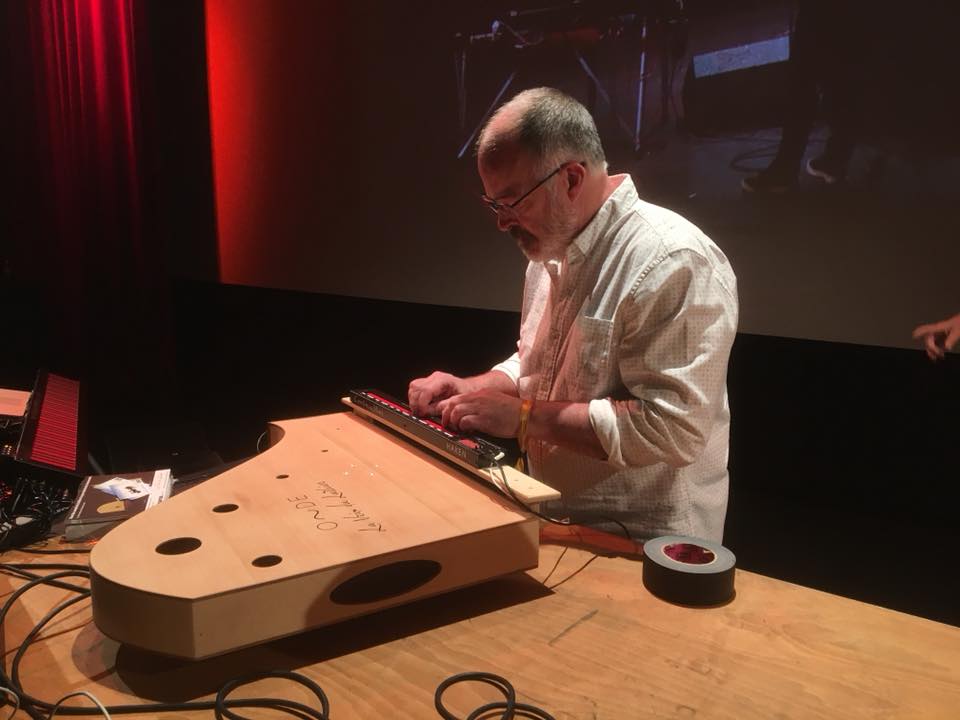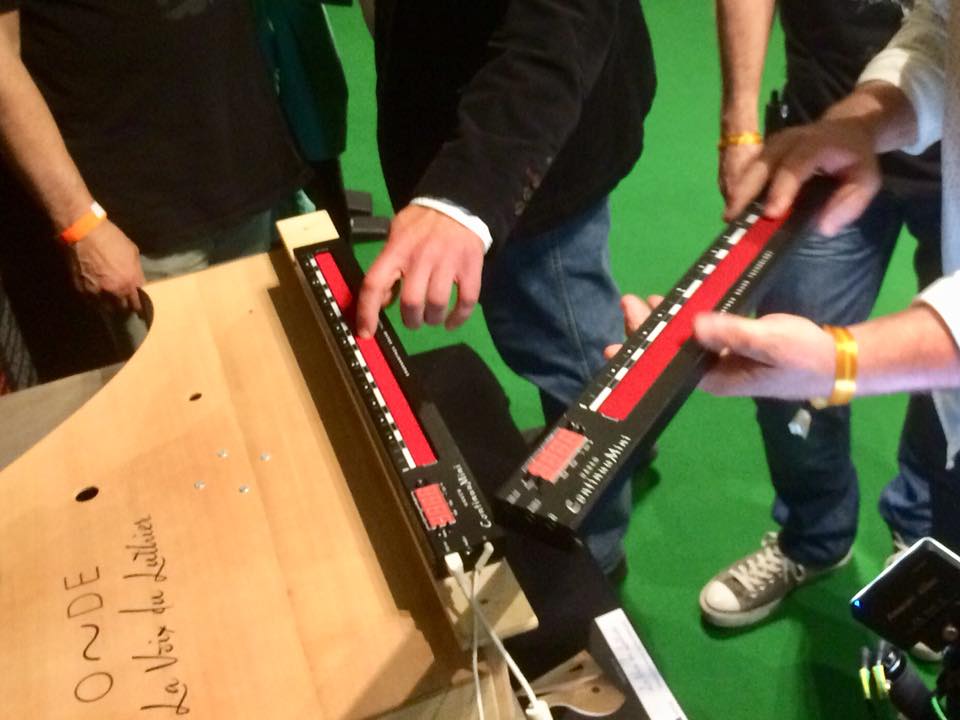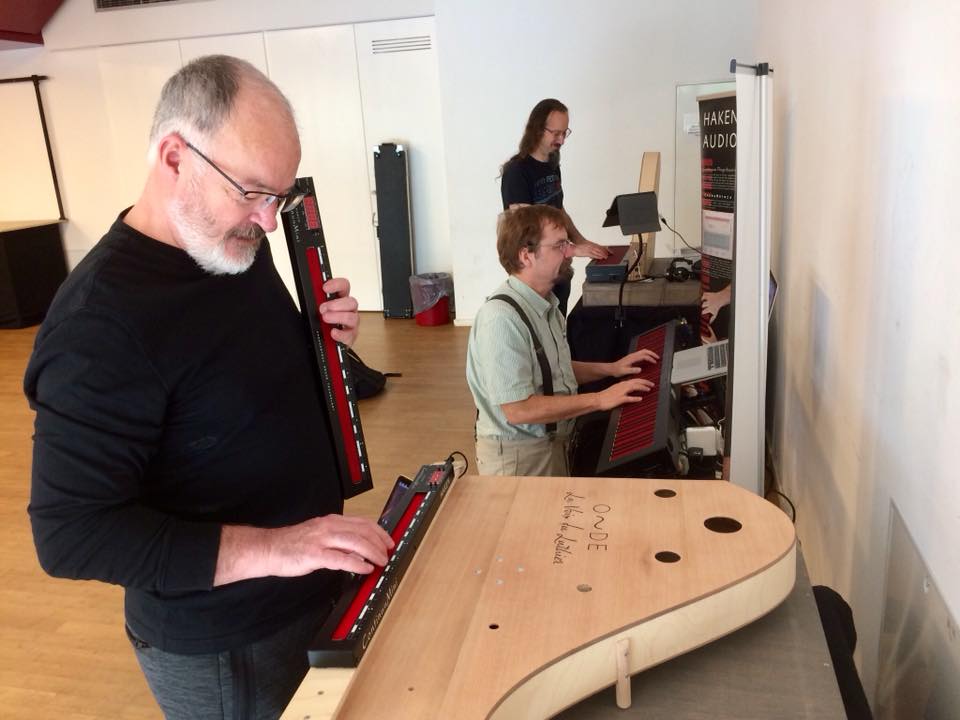The ContinuuMini
Portable. Affordable. Expressive.
The ContinuuMini has been designed to be a portable and more affordable version of Haken Audio's larger Continuum Fingerboards. The ContinuuMini is fun to play, has the same sound engine as the larger Continuums, and delivers it’s own unique and rewarding musical performance experience.
The ContinuuMini's BIG BROTHER: The Continuum Fingerboard
Dr. Lippold Haken started development over 35 years ago on what was to become the modern Continuum Fingerboard. Today, the Continuum has established itself as the premier multidimensional controller surface ever designed. It has been in the vanguard for expressive control ever since it’s inception as a commercial product at the beginning of this century. Many varied artists from around the world have discovered the beautiful experience that the Continuum can deliver: an amazing acoustic-like experience that really opens the door for countless types of outstanding musical expression.
Besides being a versatile controller with the ability to connect to the external world via Midi and analog control voltage, the Continuum excels as a complete musical instrument, thanks to it’s internal sound engine, the EaganMatrix. The EaganMatrix is the brainchild of Canadian sound designer and Continuum performer Edmund Eagan.
The EaganMatrix creates an exceptional connection between playing surface and sound engine. It’s novel matrix design and deep modulation structure allows for unprecedented integration with the Continuum playing surface. These two major components come together to form the most expressive digital musical instrument ever made.
Enter the ContinuuMini
Now a similar playing experience is available in a new compact affordable package, the ContinuuMini. The ContinuuMini has exactly the same sound engine as the full-sized Continuum Fingerboard, delivering the same level of sound quality that Continuum owners have come to enjoy.
The playing surface of the ContinuuMini has been designed to translate finger movement from one or two fingers at a time into beautiful musical expression. While based on similar design philosophies as the Continuum Fingerboard, the ContinuuMini is not just a smaller version of a big Continuum — the ContinuuMini has it’s own unique playing experience. The Mini’s playing surface can respond to incredible light touch, which leverages an underused aspect of human control, the ability of the hand to deliver delicate light touch finger input. Lighter than playing a piano, or strumming a guitar, or even lighter than the action of modern Midi keyboard controllers.
Nuances of finger movement are captured and translated into sound through interaction with this highly-optimized playing surface. And complete control of the fully programmable EaganMatrix sound engine opens up a world of sonic possibilities.
Due to it’s robust bidirectional implementation of MPE and MPE+, the ContinuuMini can control external synths or be played by external Midi controllers.
The pedal input can be used as a continuous sustain pedal input, for dynamic sustain or a variety of other uses within the EaganMatrix.
The pedal input can also function as a bidirectional serial port. Currently this communicates with control voltage convertors, like Haken Audio’s CVC or Evaton Technologies microCVC, useful for interfacing with analog modular systems. We’re excited about the possibilities of future uses for this port, further harnessing the EaganMatrix engine in new and novel ways.
We are very proud of how we have been able to leverage our decades of hardware and software expertise into the ContinuuMini. The ContinuumMini fulfills a need for a small portable musical instrument that is intimate and expressive.
SEE HOW IT WORKS
In the first video below, Edmund Eagan plays a variety of ContnuuMini presets. He is using the Onde resonator from La Voix du Luthier in place of a loudspeaker, to further enhance the acoustic-like playing experience.
SPECIFICATION SHEET
FREQUENTLY ASKED CONTINUUMINI QUESTIONS
So from what I can see, correct me if I'm wrong, it is polyphonic but the pitch bend/slide is not? +
The ContinuuMini’s synth engine is up to 8-voice polyphonic, but its playing surface can detect only one (or, in a limited way, two) fingers at a time. When you touch the surface with two fingers, it can detect the two pitches each with independent bend/slide, but only one overall pressure. The polyphony you hear comes from different things depending on how the preset is programmed: it can be from notes that decay a long time after you release your finger, or from sustain pedal, or from internal sound generation based on notes you played in the past.
I tried playing a Continuum Fingerboard and loved it! Does the ContinuuMini have the same sensitivity? +
The ContinuuMini has great sensitivity, but not the same playing surface feel as the Half-size and Full-size Contiunuum Fingerboards. The ContinuuMini’s pitch accuracy, pressure sensitivity, and fast response makes it a super-sensitive instrument. But the ContinuuMini does not feel like a tiny Continuum Fingerboard. It has its own unique playing surface feel: the Continuum Fingerboards have an advanced Hall Effect Sensor playing surface; the ContinuuMini has a Hybrid Hall Effect/Strip playing surface. Still, the ContinuuMini combines great sensitivity and the EaganMatrix sound engine, and that is essential – with that combination, different kinds of playing surfaces will be able to make good player-in-the-timbre-feedback-loop experience. It is a bit like in the acoustic world, where so many different woodwind, brass, and string instruments all have high sensitivity each in their own way, so each can make uniquely amazing music.
What might be the advantages of having TWO ContinuuMinis? +
The straightforward use for two ContinuuMinis (or ContinuuMini + Continuum) is to mix their audio outputs, much like output of KorgTritonExtreme and Continuum and mixed for beautiful results in this video: https://www.youtube.com/watch?v=Sa9Vx0svwdM ... More obscure linkage is possible via Midi: you can have Midi out from one ContinuuMini sent to a second ContinuuMini, and custom-implement presets that process two playing surfaces at once. (The possibilities are more limited with ContinuuMinis than with Continuums, since ContinuuMinis have neither Audio Input nor the high-speed AES link used in Continuum EaganMatrix Expanders.)
Can you use another MPE controller to play the ContinuuMini's internal sound engine? +
All the MPE controllers I know of use the "MPE Strike" (which is the exact same thing as "Midi Key Velocity") to represent the whole of the attack trajectory of a note. Most EaganMatrix presets are designed assuming much more information about the attack trajectory (not just one 7 bit number), so while the presets will play, they won't sound the same as they would with a ContinuuMini.
In Edmund Eagan’s ContinuuMini introduction video, he uses the xKey in one part of the video -- the xKey is not itself an MPE controller, but MPE specifies that channel 1 can have "traditional Midi" polyphonic notes on it. In the example, the ContinuuMini is set up to expect MPE in, so this works since polyphonic-Midi-on-channel-1 is subsumed in the MPE standard.
What is the proper way to connect a pedal to the Mini? +
We strongly recommend you use HOSA MHE-100.5 to adapt the ContinuuMini’s 1/8th inch TRS to your pedal’s quarter inch TRS. The HOSA MHE-100.5 does a good job at strain relief (because of its right angle design) and it is available in many on-line stores.
What are the proper pedals to use with the Mini? +
The ContinuuMini is designed specifically for the Yamaha FC7, FC3/FC3A, FC4, and FC5 pedals (for details navigate to Support then User Guides on this web site; the Continuum User Guide has a section about pedals). We chose the Yamaha pedals because they are well-built and inexpensive and available everywhere. The FC3A (or FC3) is especially nice: it is continuous-valued and return-to-zero. Other brands of pedals will work if they are electrically equivalent to the Yamaha.
Will the ContinuuMini interface with DAWs? +
Yes, the ContinuuMini will interface well with most DAWs. Edmund Eagan (the inventor of the EaganMatrix) uses Logic Pro with his ContinuuMini and his Continuum. Be sure you select a DAW (like Logic) that supports recording on multiple Midi channels simultaneously, critical for recording Continuum Midi (or any MPE Midi for that matter).
Ed has used Logic to record Midi from the Mini and play it back into the Mini again, and it all works fine. You can play into any MPE-capable Midi synth.
PLEASE NOTE: Ed finds it more useful to record the audio from the Mini’s EaganMatrix sound engine into DAWs, and not use DAWs as Midi recording tools. These are his reasons:
(1) The Mini’s sound engine has been specifically designed for Mini performance data. It’s a nice marriage.
(2) Recording audio in modern DAWs still means you have a lot of post-processing flexibility. You can still transpose, quantize, and otherwise process the audio like it was Midi data.
(3) If you use a Midi performance from the Mini for another Mini preset, you may get less-than-desirable results, because each preset requires a different playing technique. You won’t perform a “saxophone” preset like a “marimba” preset. Switching presets makes a lot of sense for Midi keyboards or MPE controllers that have low bandwidth information, because it is the same to play any preset -- but for the ContinuuMini your finger motions are controlling timbre details, and those motions won’t make sense with a different preset. … Still, it may be useful to try as there can be some happy accidents.
(4) Quantizing in a DAW does not respect the timing relationship of continuous controller events and the note placements. I believe only Steinberg’s Cubase can do this (tie performance cc lines to notes). So if you move a note, your other performance parameters don’t change in time. So in that sense you lose the flexibility in moving Midi data.
How can you connect an xKey Midi keyboard to the ContinuuMini while still powering both? +
Two possibilities:
(1) ContinuuMini and xKey powered and connected through a computer running the Continuum Editor.
(2) Use a USB host that can pass the Midi data from the xKey into the Continuum – not a generic USB hub, but a Midi-hosting hub.
Can I connect Midi to a ContinuuMini using the new 1/8 inch Midi cable standard? +
No. At this time, the ContinuuMini only has USB-Midi.
How many factory presets are there? +
There over 500. The presets correspond to those included in a Full-size and Half-size Continuum Fingerboard, but most are modified for the different playing experience of a ContinuuMini.
Will it be possible to modify factory presets by hooking it up to a computer? +
Yes, you can modify all the EaganMatrix system presets, or make new presets of your own. The Continuum Editor program is available for Mac and PC ( https://www.hakenaudio.com/editor-and-firmware ). But please note the following:
(1) The Continuum Editor is nonfunctional unless you have a ContinuuMini (or Continuum) hooked up. The Continuum Editor is really just a user interface for what is inside your ContinuuMini.
(2) The EaganMatrix is a revolutionary new way to design sounds, and will require new skills and learning. For an introduction, please watch Loopop’s and Cuckoo’s videos ( https://www.hakenaudio.com/introduction-videos ).
(3) More detail about the EaganMatrix is available in the EaganMatrix User Guide ( https://www.hakenaudio.com/editor-and-firmware ), and Richard Kram’s EaganMatrix Programming YouTube channel ( https://www.youtube.com/channel/UCbLVeRNRaGubdyhHGkCn5tQ/videos ).
The description says it "offers continuous control in three dimensions." I thought it's only two dimensions, because the strip doesn't look too big? +
The ContinuuMini has three dimensions “X, Y, and Z” like the big Continuums, except on a much more limited scale. On the ContinuuMini, the “Y” dimension corresponds to the ability to rock the playing surface so the near side or far side is higher. This "Y" dimension is much less precise than the "X" (pitch) and "Z" (pressure) dimensions, but it is useful for things like overblow effects on wind-like sounds.
When I play the ContinuuMini with a second finger, I notice a slight pitch shift in the first finger, even though I didn't move the first one. Why is that happening?+
A slight pitch shift when playing with two fingers is normal behaviour for a ContinuuMini. It has to do with the technology involved in deriving pitch, and a reason we market the ContinuuMini with a polyphony of “1 finger, 2 limited”. When one finger is on the ContinuuMini surface pitch information is derived from positioning info from the left and the right ends of the strip, so the centre of the finger can be detected. When two fingers are on the strip, the pitch is derived for each finger discreetly from the closest edge of the strip. Consequently it can’t tell where the centre is, since the strip can’t decide how “fat” the finger is. So it uses the edge of the finger. You’ll notice that if you play a note, and then play a note below it, the first note will slightly (but predictably) rise sharp. If you do the reverse (low finger first) the pitch will slightly (but predictably) fall flat.
We had experimented with different plays to compensate for this, and after a number of tries realized it’s best just to leave it the way it is. With different playing techniques the actual centre of each finger will shift, and there is no way for the software to compensate for finger width.
So we left it with a very predictable situation. That’s the nice thing here, in that this shift can be compensated for once you get a feel for it, as it’s completely predictable depending on one’s playing style.
This pitch deviation for two finger play is in addition to the fact that two fingers share the same pressure and front-to-back info, hence again the slogan about polyphony “1 finger, 2 limited”.
What is the proper way to connect the MINI to my home stereo? +
You will want to use a cable like HOSA CMR-206. But you may also need a Ground Loop Isolator; please see the FAQ on that topic.
What is the proper way to get mono audio output from my MINI? +
You must use a TRS to dual-TS breakout cable; such a cable will give you the left channel and the right channel as a mono signal, like HOSA YMM-261 or HOSA YMP-137. Then you can connect your equipment to either the left channel or the right channel. Never plug a TS cable into the headpohone TRS output of your Mini. In addition to the breakout cable, you may also need a Ground Loop Isolator; please see the FAQ on that topic.
Do I need a Ground Loop Noise Isolator? +
You will never need an Isolator while you have headphones plugged into your ContinuuMini. But when you connect your ContinuuMini to your home stereo, or a studio amplifier, or an a/d converter to your DAW – then you might need an Isolator. Only use an Isolator if you need it – try the connection first without Isolator – if it sounds good, great! If you hear noise, then insert a Ground Loop Isolator.
More technical details, in case you are interested: You want one and only one ground connection between the ContinuuMini and whatever you connect it to. For headphones and battery-powered speakers, the audio cable provides this one ground connection. But in a home or studio setup, there might be multiple ground paths. While USB connections are convenient, they are not ground-isolated like traditional DIN-5 Midi, so it is easy to get ground loops. If you hear ground loop noise, it is easy to fix: use an Isolator. If it sounds good without an Isolator, avoid using an Isolator, as it may remove the only ground path. Typically isolators consist of two matched transformers, one for the right channel audio and one for the left channel audio.
Can I attach a strap and play it in more of a "keytar" like configuration? +
Yes, you can play the ContinuuMini vertically. You can run the USB cable along your strap to a battery along with the audio cable. You might want to get USB and audio cables with right-angle connectors to make them neat and compact on stage. If you are interested in this idea, you may want to check out Randy George's accessory package for the ContinuuMini, the Performer Case at http://www.randygeorgemusic.com/performercase/. BTW if you decide you want to play with your thumb on the backside of the Mini, there are cutouts in the sticker on the back side that you can feel with your thumb and use for reference positions for your hand. We call the cutouts “Mouquets”, for Deep Forest’s Eric Mouquet who gave us this idea. We love the idea of playing this way, but until we see people do it we do not know if it will be easy!
Can hold the ContinuuMini in front of me and play it with both hands like a clarinet or oboe? +
Yes! You will want to place your thumbs on Moquets on the underside to keep your hand position reference as you play. (Mouquets are cutouts in the sticker on the back side of the Mini that you can feel with your thumb and use for reference positions for your hand. We call the cutouts “Mouquets”, for Deep Forest’s Eric Mouquet who gave us this idea at ContinuuCon 2018.) If you are in a DIY mood: It may be possible to connect your breath controller to the Ped/Ext input in place of a pedal. That depends on the the voltage range of your breath controller, and on an 1/8th cable connection to the Continuum. If it works, you will want to customize sounds for it because it will not be the same range or feel as a pedal.
The note I am playing on the ContinuuMini no longer lines up with the piano key reference, and sometimes I hear two notes!? +
Your ContinuuMini has lost its "ContinuuMini Factory Calibration". Follow the directions in a recent User Guide to redo the ContinuuMini Factory Calibration. If you have no success with this, please contact Haken Audio support using the Contact button on this website, and we will zoom you through the process.
How do I play precise microtonal pitches on my ContinuuMini, without being restricted to a predefined scale? +
Be sure you turn off the Round Rate and Round Initial on the preset you are playing, so your finger position directly controls pitch. Place or slide your finger close to your desired pitch, then roll your finger (don't slide!) as you carefully listen to get the exact pitch.
More details, in case you are interested: This same technique is used by violinists. A violinist doesn't glissando and land on a precise pitch. Instead, violinists glissando very close to the final pitch (or place their finger very near final pitch, if that finger was not already on the string), and then adjust by rolling the finger side-to-side while closely listening. It is not possible to gliss to exact pitches because of the slip-stick effects between violin player's fingers and the fingerboard and string -- but rolling a finger avoids those effects. A finger never glisses totally smoothly on a violin; in fact, if the violin's fingerboard becomes so slick that glissando is totally smooth (I remember sweating too much under stage lights so that my violin's fingerboard became slick) then vibrato and "normal" playing are negatively impacted. .... Similar slip-stick effects occur on a ContinuuMini and Continuum playing surface, so hone in on exact pitches by rolling (not sliding!) your finger as you carefully listen.
I want a case for my ContinuuMini. What do you suggest? +
You might like the "Alvin MT25-CL". You can also use a 2.5 inch diameter mailing tube (24 inches long) with screw-in endcaps. As well you should check out Randy George's accessory package for the ContinuuMini, the Performer Case at http://www.randygeorgemusic.com/performercase/.
What are the enclosure and playing surface made of? +
The ContinuuMini enclosure is aluminum. The Playing surface has red nylon on a thin layer of neoprene, covering a custom-manufactured ribbon attached to a movable aluminum plate. The movable plate is supported by two piano wire springs, and neodymium magnets at each corner. Four hall-effect sensors track the movement of the plate. (This is a much simpler arrangement than the hundreds of precision-machined rods, springs, magnets, and hall-effect sensors in the big Continuum Fingerboards.)










